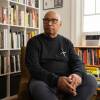On a bustling, if typical, late weekday morning in the Back Bay, the usual sounds of the city dominate the scene: buses rumbling by, the chatter of pedestrians. But on the south side of Boylston Street, just outside the entrance to the Boston Public Library, something a little different: Piano music, rising above it all.
Andrew Safioleas, a pharmacist from New Bedford, sidled up to a vibrant, almost psychedelic piano covered in swirling colors and hand prints—entertaining a small, improvised crowd with an improvised piece. This piano is just one of 60 scattered in public places throughout the Boston area right now, that anyone can play. It’s part of a traveling international installation called " Play Me, I’m Yours ," sponsored here by the Celebrity Series of Boston. If the aim is to bring a little unexpected music into people’s day then, at least here, it’s working.
"That’s beautiful—it’s melody—and it’s got feelings," remarked 80-year old Cynthia Gums, from Boston, as she ambled by.
Nearby, Jackie Cabral cradled her young daughter in her arms, swaying along to the music. She told me her daughter was the one who asked to stop and listen—and that was just fine by her. "Its perfect," she said. "What's better than listening to live music?"
Ali Shahim, himself a piano player, made no bones about what he had just experienced. "I think it was some of best piano playing I’ve ever listened to," he said.
Each piano is also decorated by a local artist, with designs ranging from the whimsical to the stately to the surreal. And while it’s easy to think of the visual component of a public piano installation as an afterthought—a little additional flair—it’s anything but for Felicity Lingle.
"I love public art," she told me. "The color is like visual eye candy, and it makes you just stop and relax for a moment. Just something interesting that catches the eye."
I came across Lingle the previous day. It was clear that this piano had done more than just catch her eye—which is why she caught my eye. She was examining it, studying it as if it were a puzzle to be solved.
"It’s decorated with sign language," she pointed out. "There’s the ‘I love you' symbol in sign language, and then there’s fingers spelling characters from the American Sign Language alphabet saying, 'Play Me I’m Yours.'"
American Sign Language is—more often than not—how Lingle communicates these days.
"I have a disease called neurofibromatosis, type 2," she said. "I began losing my hearing around [age] 20, and now, 20 years later, I’m completely deaf."
Lingle says that seeing those fingers painted across the piano felt like someone was reaching out to her.
"Yeah, it does make me feel included," she said. "It’s wonderful to see your language be recognized, and know that people are aware that not everyone can hear. Yeah, it feels good."
"The design has been sort of an idea I’ve been thinking about for a couple of years," explained Lou Lim, the Medford artist who painted this piano. "This idea of incorporating hands into art. Just the power of hands and the story that hands can communicate."
Lim is not deaf, nor are any members of his family. But years back, while attending a small church in Florida, he was encouraged to learn sign language, which he did. What started as a lark for him turned into something far more valuable.
"Ultimately, sign language was a means to help me get out of myself to express what I was feeling and thinking," he said.
For Lingle, Lim’s gesture was more than just a nod of inclusion. As she points out, she was able to hear music for 35 years, and even something as simple as seeing on old music video, or, yes, a piano on a busy city street can—in a way—help her hear it once again.
"I still enjoy the memories of songs that can play in my head," she explained. "I can hear it better in my mind when I see it. The brain, I think, kind of fills in the gaps to make sense of it."
When I told Lim about my encounter with Lingle, he was thrilled. After all, he says, public art is just that: art that is meant for everyone.
"Oh my goodness, that is wonderful," he said. "That was one of my hopes with painting this piano. We want anybody who has any level of interest with art, music, community building to relate. To engage and interact with it. I think the artists all would want people to connect and just be with it."
Lou Lim's piano—and 59 others are in the Boston area—are waiting to be played, through October 10.




